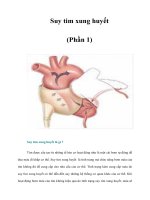Liệu suy tim có thể gây ra thiếu máu cơ tim
Bạn đang xem bản rút gọn của tài liệu. Xem và tải ngay bản đầy đủ của tài liệu tại đây (627.4 KB, 13 trang )
NEW TEST TO PREDICT WHICH
HEART FAILURE PATIENTS
WILL HAVE BUN AND
CREATININE INCREASED BY
DIURETICS
Thach Nguyen, Dinh Quang Minh Tri
BACKGROUND
Current management of heart failure (HF) includes
intravenous or oral diuretic.
In many cases, diuretics caused severe increase of
blood urea nitrogen (BUN) or creatinine level.
=> Discontinuation of diuretics or even resumption
of IV fluid
QUESTIONS
How to predict which HF patient will develop increase of
BUN and creatinine or renal failure with diuretic?
Methods
Divided in 2 groups:
Group 1: conventional treatment.
Group 2: the new Size and Expansion of the Femoral Vein
(SEFV) of which the results were shown to the investigators.
Methods
Principles on the Size and Expansion of the Femoral
Vein (SEFV) test
The first principle:
The volume of blood going through the femoral artery
= returning through the common femoral vein.
The size of the femoral artery = the femoral vein.
The amount of venous return is lower => edema in the
lower leg
Methods
Principles on the Size and Expansion of the Femoral
Vein (SEFV) test
The second principle:
The size of the femoral vein can change from the same
size to the femoral artery or to be bigger depending on
the amount of blood in the intravascular compartment.
=> Fairly accurate method to assess the arterial and
venous volume could be achieved.
Methods
New Non-Invasive SEFV Test
Examinaton the size of the femoral vein and
its expansion with cough.
Check in the coronal plane immediately
proximal to the bifurcation of the superficial
and deep femoral artery
The size of the femoral vein is a little larger
than the size of the common femoral artery
Methods
New Non-Invasive SEFV Test
Figure 1.
Methods
New Non-Invasive SEFV Test
Figure 2.
Methods
New Non-Invasive SEFV Test
Figure 3.
Results
25 patients with acute on chronic systolic HF - December
2015 to May 2016.
20/25 patients had abnormal SEFV test.
18/20 of these patients did not have increase BUN or
creatinine.
One patient had small femoral vein and only 20mg of
furosemide brought his creatinine from 0.9mg to 2.0mg
overnight.
Conclusions
The patients with HF should have the SEFV early and its results
helped to guide the use of diuretics without causing renal failure
THANKS FOR LISTENING









